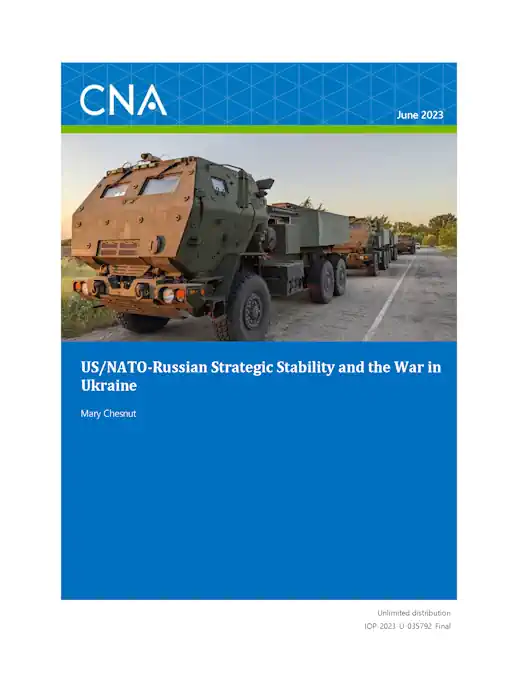Introduction
This paper analyzes the role of nuclear weapons in Russia’s war in Ukraine as well as the war’s impact on overall US/North Atlantic Treaty Organization (NATO)–Russian strategic stability. Strategic stability refers to the existence of two conditions: (1) crisis stability, where there is no incentive for either country to conduct a first nuclear strike, and (2) arms race stability, where there is no incentive for either country to augment its nuclear arsenal to gain significant advantages over the other’s. The paper uses open-source data to analyze the immediate and longer-terms impacts of the Russo-Ukrainian war on both crisis stability and on arms race stability. Because many of the potential nuclear escalation pathways involve escalation from the use of conventional (non-nuclear) weapons, this paper also necessarily explores the interactions between conventional war and potential nuclear use.
This paper begins by applying an existing framework for understanding escalation to examine US/NATO-Russian strategic stability in the Russo-Ukrainian war. After assessing real and hypothetical instances of horizontal and vertical escalation, it appears that avoiding and deterring horizontal escalation on both sides, at least in this conflict, may be easier and more successful given appreciation for the inherent risks of two nuclear weapons states fighting each other directly. By contrast, vertical escalation may be more challenging to deter, and red lines may be harder to gauge. This is in part due to the fact that the effects of Western vertical escalation may compound slowly over time. Two major additional escalation challenges arise where there is significant ambiguity between sides: (1) What does Russia consider “Russian homeland” or “Russian territory”?, and (2) When does Western support become direct involvement? The inherent ambiguity in these questions presents opportunities for deliberate risk manipulation as well as miscalculation.
In addition, while the US has attempted to prevent the deterioration of crisis stability from having a spillover impact on arms race stability by de-linking the two issues, Russia has consistently stressed throughout the conflict that it could not divorce the matter of bilateral arms control from “geopolitical realities.” As a result of Russia’s invasion of Ukraine and its subsequent political linkages, the future of the New START nuclear agreement and of US-Russian nuclear arms control is uncertain. Although this case study alone is not sufficient in demonstrating any broader relationship between crisis stability and arms race stability, it does highlight the fragility of even a legally binding arms control treaty in the context of worsening peer competitor relations, and the fact that both parties must be willing to continue complying with and implementing the agreement for its sustained success.
Finally, there are a variety of wide-ranging near-term and long-term impacts that flow from Russia’s invasion of Ukraine. Near-term impacts include several NATO reactions to enhance security and reassure alliance members, the stagnation of the Strategic Stability Dialogue (SSD), and Russia’s suspension of and noncompliance with the New START treaty. In the long term, the security dilemma response loop poses significant risks for US-Russia and NATO-Russia relations, Russia may have an increased Russian reliance on its nuclear arsenal, and the already-complicated environment for negotiating future US-Russian bilateral nuclear arms control agreements may become more tenuous.
Background
On February 24, 2022, Vladimir Putin announced Russia’s “special military operation” in Ukraine, following more than eight years of conflict after Moscow’s annexation of Crimea and the prolonged presence of Russian-backed separatists in the Donbas region of eastern Ukraine. Following a buildup of well over 100,000 troops on Ukraine’s border, and repeated denials that it was planning to invade its neighbor, Putin ordered the Russian invasion in order to “protect people who, for eight years now, have been facing humiliation and genocide perpetrated by the Kyiv regime,” adding that Russia “will seek to demilitarize and denazify Ukraine.” Moscow also routinely justified its invasion by falsely claiming that Ukraine was seeking to acquire nuclear weapons, and that the US and Ukraine were involved in creating biological weapons.
In addition to Russia’s protracted conflict with Ukraine, parts of the war have involved or referenced Russia’s relationship with the NATO alliance, even though the alliance is not formally involved. In the weeks leading up to the invasion, Moscow presented two “draft treaties” to the US and NATO containing security demands widely viewed as non-starters by Washington and Brussels—including to withdraw NATO forces from Eastern Europe, forgo future NATO expansion, and “not implement security measures that could undermine core security interests” of Russia. Although the US rejected the security demands, Secretary of State Antony Blinken offered what he called a “serious diplomatic path” to resolving
Moscow’s security concerns. However, Putin did not opt for this approach. In the February 24 speech in which he announced the “special military operation,” Putin said in reference to Ukraine,
The problem is that in territories adjacent to Russia, which I have to note is our historical land, a hostile “anti-Russia” is taking shape. Fully controlled from the outside, they are doing everything to attract NATO armed forces and obtain cutting-edge weapons.… It is not only a very real threat to our interests but to the very existence of our state and to its sovereignty. It is the red line which we have spoken about on numerous occasions. They have crossed it.
Similar sentiments were highlighted in Putin’s address to the Federal Assembly three days earlier, where NATO was mentioned 41 times.
Nuclear threats, signaling, and the fear of Russia’s use of nuclear weapons have played a significant role in the war in Ukraine since the very beginning of the conflict, when Putin threatened that if any external actors attempted to interfere, Russia would respond “immediately, and the consequences will be such as you have never seen in your entire history.”9 Such threats, as well as the overall decline in strategic stability between Russia and the US/NATO, are examined in greater detail in the subsequent portions of this paper.
Download reportDISTRIBUTION STATEMENT A. Approved for public release: distribution unlimited.
Details
- Pages: 53
- Document Number: IOP-2023-U-035792-Final
- Publication Date: 6/6/2023
